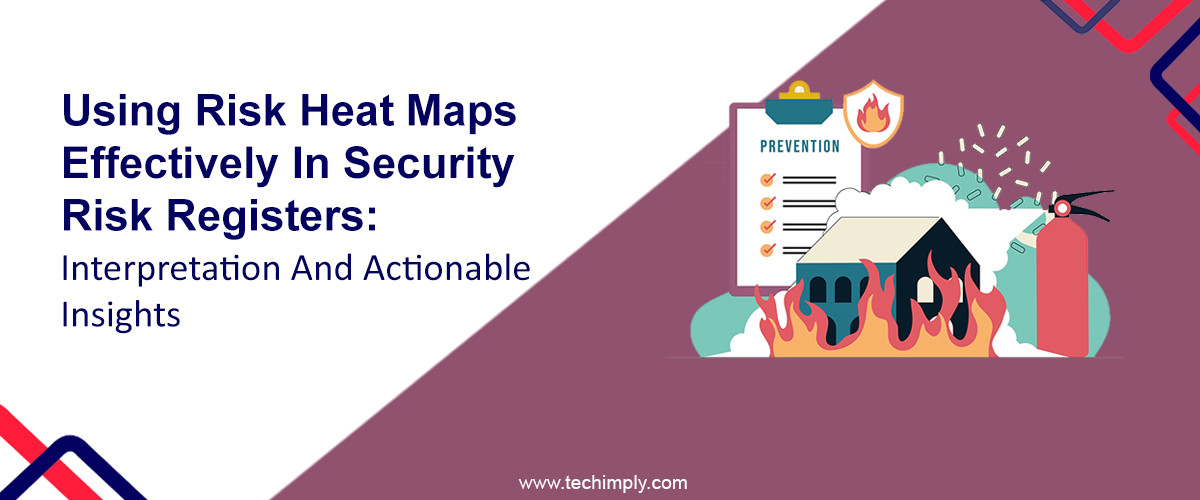In today's complex digital landscape, organizations encounter multifaceted security risks that demand a comprehensive understanding and strategic management approach. Among the myriad tools available to manage risks effectively, the use of risk heat maps within security risk registers stands out as a valuable visual aid. When utilized adeptly, these heat maps offer a clear and concise representation of potential threats, enabling businesses to interpret and derive actionable insights for informed decision-making and risk mitigation strategies.
Understanding Risk Heat Maps
Risk heat maps are graphical representations that visually display the likelihood and impact of various risks. Typically, they employ color gradients to illustrate the severity of risks, with high-risk areas depicted in bold colors like red or orange, and lower risks in cooler colors like yellow or green. In the context of security risk registers, these maps enable stakeholders to swiftly identify critical areas that require immediate attention.
Interpreting Risk Heat Maps
1. Identification of High-Risk Areas
Risk heat maps use color gradients to signify the severity of risks, aiding in the swift identification of critical areas. Understanding the significance of these colors and their placement within the map is crucial:
Color Coding:
-
High-Risk Zones: Regions marked in intense colors (e.g., red) indicate high-risk areas that demand immediate attention.
-
Moderate and Low-Risk Zones: Cooler colors (e.g., yellow, green) represent areas with comparatively lower risks.
Cluster Analysis:
-
Identifying clusters of high-risk elements can suggest potential systemic vulnerabilities or areas where multiple risks converge, magnifying their impact.
2. Assessing Likelihood and Impact
Risk heat maps position risks based on their likelihood of occurrence and potential impact. Understanding how these factors are depicted aids in gauging the severity and urgency of each risk:
-
Probabilistic Analysis: Positioning risks within the map helps in understanding not only the likelihood of their occurrence but also the magnitude of their potential impact if they materialize.
-
Risk Trend Analysis: Observing changes in the positioning of risks over time enables the identification of emerging threats or declining vulnerabilities, facilitating proactive risk management strategies.
3. Prioritization and Resource Allocation
Interpreting risk heat maps helps in prioritizing risks and allocating resources judiciously:
-
Focus on Critical Risks: Identifying high-risk areas allows for the prioritization of resource allocation toward mitigating the most critical risks.
-
Decision Support Tool: Offers insights for informed decision-making regarding risk response strategies, resource allocation, and long-term planning.
4. Contextual Analysis and Additional Insights
-
Comparative Analysis: Comparing multiple heat maps over different periods or across various segments of the organization helps in identifying trends, improvements, or deteriorations in risk profiles.
-
Layering Additional Data: Incorporating additional data layers (e.g., historical data, geographical information, threat intelligence) onto the heat map can provide a more nuanced understanding of risks in different contexts.
-
Heat Map Thresholds and Definitions: Establishing clear thresholds and definitions for risk categories helps in standardizing interpretations across stakeholders, ensuring consistent understanding and actions.
Benefits of Comprehensive Interpretation
-
Holistic Risk Understanding: Enables stakeholders to grasp the complete risk landscape comprehensively, allowing for informed decision-making.
-
Proactive Risk Management: Identifying trends and high-risk areas empowers organizations to take proactive measures to mitigate potential threats before they escalate.
-
Efficient Resource Allocation: Facilitates resource allocation by directing efforts towards critical areas with higher potential impact.
Leveraging Insights for Actionable Outcomes
1. Risk Mitigation Strategies
Targeted Action Plans:
-
Identify high-risk areas highlighted in the heat map and devise specific, targeted action plans to mitigate these risks effectively.
-
Tailor mitigation strategies are based on the nature and severity of identified risks.
Resource Optimization:
-
Allocate resources efficiently by focusing on high-impact risks identified through the heat map interpretation.
-
Ensure resources are directed towards areas where they can make the most significant difference in reducing vulnerabilities.
2. Continuous Monitoring and Adaptation
Regular Review:
-
Continuously monitor and update the risk heat map to reflect changes in the threat landscape and evolving risks.
-
Incorporate new data, threat intelligence, or risk assessments to ensure the heat map remains current and relevant.
Adaptive Strategies:
-
Adapt risk management strategies based on the insights derived from the heat map interpretation.
-
Modify existing strategies to address emerging risks or changing threat scenarios effectively.
3. Communication and Stakeholder Engagement
Clarity in Communication:
-
Use the heat map as a communication tool to convey complex security risks to stakeholders clearly and understandably.
-
Highlight critical areas and their implications to facilitate informed discussions and decision-making.
Engagement and Alignment:
-
Foster stakeholder engagement by involving them in the interpretation of heat maps and aligning them towards shared risk management objectives.
-
Encourage collaboration among teams to collectively address identified risks and implement mitigation measures.
4. Scenario Planning and Contingency Preparedness
Scenario Analysis:
-
Use insights from the heat map to conduct scenario planning exercises, simulating potential risk scenarios to evaluate preparedness.
-
Identify gaps in current strategies and develop contingency plans based on possible risk outcomes.
Resilience Building:
-
Focus on building organizational resilience by integrating insights from the heat map into business continuity and incident response plans.
-
Enhance preparedness to effectively respond to and recover from security incidents.
5. Performance Measurement and Improvement
Key Performance Indicators (KPIs):
-
Define and track KPIs related to risk mitigation efforts based on heat map insights.
-
Monitor progress and evaluate the effectiveness of implemented strategies in reducing identified risks.
Iterative Improvement:
-
Use feedback loops and lessons learned from risk mitigation efforts to continuously improve and refine strategies.
-
Apply iterative improvements based on the outcomes and experiences gained from managing identified risks.
Benefits of Actionable Insights Utilization
1. Proactive Risk Management Culture:
Encourages a culture of proactive risk management by translating insights into tangible actions and strategies.
2. Adaptive and Resilient Framework:
Facilitates the development of an adaptive framework capable of responding swiftly to evolving risks and uncertainties.
3. Efficient Resource Utilization:
Optimizes resource allocation by focusing efforts on high-impact areas, maximizing the effectiveness of risk mitigation endeavors.
Best Practices for Effective Implementation
1. Data Accuracy and Consistency
-
Reliable Inputs: Ensure data integrity and consistency to avoid skewed representations.
-
Regular Updates: Keep the map current by integrating new threat intelligence and risk assessments.
2. Customization and Contextualization
-
Tailored Representations: Customize heat maps to suit organizational context and specific risk parameters.
-
Combining Metrics: Integrate other metrics or overlays for a more comprehensive risk view.
3. Training and Awareness
-
Educate Stakeholders: Ensure stakeholders understand the map's interpretation and implications for informed decision-making.
-
Training Programs: Conduct training sessions to enhance proficiency in utilizing heat maps for risk management.
Conclusion
In conclusion, leveraging risk heat maps within security risk registers is a powerful strategy for organizations to navigate complex security landscapes effectively. By interpreting these visual representations and deriving actionable insights, businesses can proactively address vulnerabilities, allocate resources judiciously, and fortify their security posture against potential threats.
Through continuous monitoring, adaptation, and strategic action based on the insights drawn from these heat maps, organizations can bolster their resilience in an ever-evolving threat environment.
Understanding the nuances of risk heat maps and utilizing them as a fundamental tool in security risk registers empowers organizations to not only identify and comprehend risks but also to take proactive measures that mitigate these risks effectively






